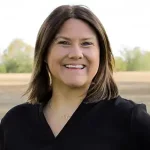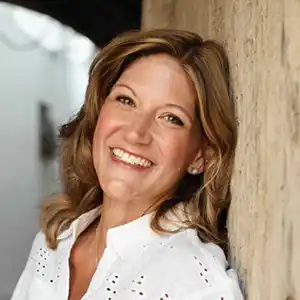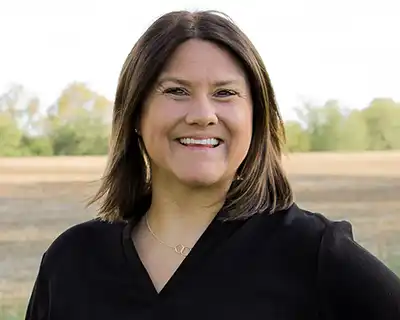Innovation Center for U.S. Dairy’s model for collaboration is helping to galvanize the industry, remove barriers for conservation and advance climate-smart agriculture
According to the Innovation Center for U.S. Dairy, their goal is a “world where U.S. dairy unlocks transformative good for people and the planet, becoming a catalyst for a healthy, sustainable future.” The checkoff-funded organization believes that to accomplish this work, a collaborative model deployed not only through the growers that it represents but throughout the entire value chain, will have the most impact.
Lori Captain, Executive Vice-President of Global Sustainability Strategy, Science and Industry Affairs, believes strongly in this model as the best way to propel the organization’s work forward.
“We employ a partnership-centric model to address barriers, advance research and find economically viable solutions for challenges faced by our farmers,” she says. “Partnerships catalyze innovation and broaden the reach of new technologies and insights, essential for fostering sustainable food systems.”
They have already seen success in employing this organizational model through the U.S. Dairy Net Zero Initiative, an ambitious and groundbreaking on-farm effort to support U.S. dairy in achieving a set of aggressive environmental goals set by the industry to help build a more sustainable food system by 2050.
“The U.S. Dairy Net Zero Initiative (NZI) exemplifies this collaborative approach, with 66 partnerships with corporations, academic and research institutions, government and non-government entities, among others in the dairy community,” Captain says. “These collaborative efforts have already empowered farms to lessen their environmental footprint, but progress toward breaking down barriers is just beginning. As NZI moves forward, we look forward to even more collaboration to forge sustainable progress for generations to come.”
America’s Conservation Ag Movement, one coalition-led program that Innovation Center for U.S. Dairy participates in, visited with Captain about this model and discussed how other coalitions are finding success at creating place-based impact toward a more sustainable future for agriculture.

of Global Sustainability Strategy,
Science and Industry Affairs
Your Industry has ambitious environmental sustainability goals. How are those grounded in ensuring that producers have the tools they need to scale conservation/mitigation in their operations?
U.S. dairy recognizes the integral role it plays in being a solution and part of the world’s environmental focus. U.S. dairy is committed to making even more progress through the industry-wide 2050 environmental stewardship goals, which address areas where we can have the greatest impact on the field, farm and processor levels. They were created through the Innovation Center for U.S. Dairy, comprised of leadership across the dairy value chain, including farmers, cooperatives, processors, retailers and other stakeholders, and included an extensive stakeholder and public comment period.
Recognizing the challenges faced by farmers in navigating the complex landscape of sustainability, we piloted a new strategy focused on supporting small and medium-sized farms called “Dairy Conservation Connect.” The program works to empower agronomists, nutritionists, veterinarians, extension agents and other professionals with the resources to effectively educate, advise and assist farmers to adopt environmental sustainability practices. Our aim is to provide a network of experts they can turn to for advice, support and guidance. We understand the overwhelming array of options and uncertainties involved in adopting sustainable practices, and we are working to simplify this journey for farmers.
Why is it important for organizations like Innovation Center for U.S. Dairy to take the lead in establishing environmental sustainability goals and doing the research needed to help producers meet those goals?
U.S. dairy recognizes the integral role it plays in being a leading environmental solution. The 2050 environmental sustainability goals were created at an industry-wide level, reflecting ambitions across the field, farm and processor levels and addressing the areas where the collective industry can have the greatest impact. The Innovation Center for U.S. Dairy, comprised of representative leadership across the dairy value chain, including farmers, cooperatives, processors, retailers and other stakeholders, crafted the goals after an extensive stakeholder and public comment period. To help farmers, cooperatives and processors meet the goals, research, analysis and experimentation create an integrated approach to identify technologies and best practices that are accessible and affordable to farms of all sizes and geographies. This reflects U.S. dairy’s commitment to sound science and a recognition that environmental progress comes with economic viability for farmers.
What updates or interim goals can you share about your Net Zero Initiative?
The U.S. Dairy Net Zero Initiative is supporting farmers to improve upon their longtime commitments to the environment through science-based actions and unlocking opportunities to accelerate progress. These efforts underscore U.S. dairy’s commitment to planetary health by fostering widespread adoption of sustainable practices and contributing to global climate and food security goals. Since launching in October 2020, NZI has:
- Initiated and supported 26 projects spanning 338 farms across 19 states
- Leveraged more than $40 million in support from partners and grants
- Partnered with 60-plus corporations, land grant and research institutions, government and non-government organizations and other dairy community stakeholders
- Led 94 presentations for national and international webinars, panels and forums
- Achieved recognition by national and international organizations, including the Agriculture Innovation Mission for Climate and U.S. Nature 4 Climate
What are some examples of your organization’s coalition-led or collaborative projects that are already creating change or that have you excited about the future impacts of?
The U.S. dairy sector is diligently working to bridge knowledge gaps and propel innovative solutions in dairy production. This is achieved through rigorous research, analysis, and modeling to pinpoint practices and technologies that align with the industry’s 2050 environmental goals. Noteworthy projects include:
The Greener Cattle Initiative is a public-private partnership spearheaded by the Innovation Center for U.S. Dairy and the Foundation for Food & Agriculture Research, which convenes stakeholders across the dairy and beef value chains to fund ambitious research and technology development aiming to reduce enteric methane emissions. This unique, global research consortium will result in knowledge critical to accelerating scalable and commercially feasible technologies. Areas of focus include: additives and supplements, genetic traits, research on the microbiome composition and technologies such as sensors, robots and artificial intelligence to monitor emissions.
Through Dairy Scale for Good, major dairy customers like Nestlé and Starbucks are partnering with dairy farms to develop on-farm pilots to assess the feasibility and viability of technologies and practices that can significantly reduce GHG emissions and improve water use and quality while increasing and diversifying farmer revenue.
To support the adoption of sustainable feed production on farms of all sizes, The Nature Conservancy (TNC) has teamed with the Innovation Center for U.S. Dairy, and partners including Foremost Farms, Michigan Milk Producers Association, and the Idaho Dairymen Association on the Dairy Feed in Focus project. The Nestlé-funded project, which is underway on farms in Wisconsin, Michigan and Idaho, focuses on reducing GHG emissions, improving soil health and water quality by increasing use of best practices in feed and forage production and feed efficiency. Technical and financial support is provided to assist farmers in choosing and implementing management practices that result in positive environmental and economic impacts.
Digging deeper into the work being done through Greener Cattle Initiative–how is this project poised to bring more options for producers for ways to mitigate enteric methane emissions?
The Greener Cattle Initiative is the first industry-oriented consortium to share knowledge, leverage investments and accelerate research to develop scalable and commercially feasible solutions that reduce enteric methane emissions. Its founding members include the Foundation for Food & Agriculture Research, the Innovation Center for U.S. Dairy, ADM, the Council on Dairy Cattle Breeding (CDCB), Elanco, Genus PLC, the National Dairy Herd Information Association, Nestlé and the New Zealand Agricultural Greenhouse Gas Research Centre (NZAGRC). The Global Methane Hub and JBS USA serve as steering committee members. The project is poised to establish, scale and verify more options for farmers by funding research to support enteric methane mitigation options that are proven, scalable and affordable.
What have been some early wins for the Greener Cattle Initiative? What is the timeline for future progress? How will it scale?
The Greener Cattle Initiative was launched as a five-year, public-private collaboration and already has become an effective mechanism to address research gaps. In 2022, the first request for research proposals was announced, and GCI received more than 100 letters of intent, which resulted in GCI awarding three grants for a total research investment of $7.2 million, surpassing its initial goal. The grants went to:
- Alexander Hristov, distinguished professor of dairy nutrition at Penn State, who will conduct research to determine the efficacy and feasibility of enteric methane inhibitor compounds in cows and work to identify and optimize dietary conditions required to maximize enteric methane emissions reductions;
- Roderick Mackie, professor in the Department of Animal Sciences at the University of Illinois Urbana-Champaign, who will lead international research on how diets and different additives affect hydrogen production and utilization in the rumen of beef and dairy cattle and how these changes affect the amount of enteric methane produced;
- Francisco Peñagaricano, assistant professor in the Animal and Dairy Sciences Department at the University of Wisconsin–Madison, who will conduct research combining interventions that address selective breeding, data on milk composition, and rumen microbes to reduce enteric methane emissions.
The knowledge created by the research will eventually result in new mitigation options for beef and dairy farmers to use to meet individual and sectorial environmental goals. This initial round of grant awards clearly illustrates the capacity GCI has to convene stakeholders, collectively identify objectives and effectively leverage resources to address them.
How are you planning to use the coalition model to tackle other issues that growers face in the dairy industry?
Through collaboration, the U.S. dairy industry is learning, establishing and validating the pathway to meet environmental challenges head-on through a holistic approach to responsible stewardship of natural resources. Recognizing the importance of establishing coalitions, NZI was established by the Innovation Center for U.S. Dairy, Dairy Management Inc., U.S. Dairy Export Council, Newtrient, National Milk Producers Federation and International Dairy Foods Association.
Our objective is to accelerate U.S. dairy environmental sustainability by developing, piloting, evaluating and sharing innovative tools and programs that break down financial and technical barriers for dairy farmers. Applying a “with and through” strategy, our focus is on improving farmers’ access to resources they need to effectively guide their environmental sustainability practice selection and implementation.
How are you using on-farm pilots and data measurement to help find solutions to issues like enteric emissions mitigation? How do you plan to socialize those findings with producers?
On-farm piloting and data measurement are critical to finding and sharing solutions. Through Dairy Scale for Good, pilot farms representing diverse management styles, geographies and infrastructure apply the latest research, models and innovations to test and establish best practices and technologies across the farm’s environmental footprint. In addition, case studies model the GHG footprints of small- to mid-sized commercial U.S. dairies, highlighting their achievements and pathways to GHG neutrality. For each dairy, three to six practices or technologies were identified that could aid in GHG reduction based on the needs of the farm, along with an estimation of the potential GHG emissions reduction and implementation costs. Researchers use FARM Environmental Stewardship, USDA COMET computer models and soil carbon samples to quantify the GHG footprint of farms.
Outcomes from the demonstration and small farm case studies will be shared across the dairy industry. A video series captured each farm’s innovative practices and technologies, lessons learned and progress, showcasing U.S. dairy’s diversity and the range of sustainability efforts led by farmers. While every dairy doesn’t need to achieve GHG neutrality for the industry to achieve its goal, these case studies highlight compelling stories of success, innovation and commitment to environmental sustainability.



